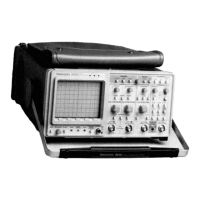3-91
The Preregulator control circuit consists primarily of
control IC U233, gate drive transformer T620, and the
associatedbias and feedbackcircuit elements.The voltage
at the primary center tap of T639 is attenuated and
appliedto the voltage-senseinput of control IC U233.This
IC varies the "on time" of a series switch, dependingon
whether the sensed voltage is too high or too low.
Transistors 0421 and 0423 form this "series switch," and
are each active during alternate switching cycles. The on-
time duty cycle of the series switch is inversely proper-
tiona~ to the rectified line voltage on C328. In normal
operation, the series switch is on about one-half of the
time. When the series switch is off, current to T639 is
through CR426.
PREREGULATOR.
The Preregulator control circuit
monitors the drive voltage reflected from the secondaryto
the primary of the Inverter output transformer T639 and
holds it at the level that produces proper supply voltages
at each of the secondarywindings.
Power Conversion
The power converter consists of a buck-type switching
Preregulator, producing width-regulated voltage pulses
that are filtered to produce a preregulateddc current, and
an Inverter stage that chops this preregulatedcurrent into
ac to drive a power transformer.The transformer has out-
put windings that provide multiple unregulateddc voltages
after rectification has taken place. The main Preregulator
components are Q421, Q423, CR426, C328, T335, T620,
and U233. The fundamental Inverter components are
Q521,Q721,T639, and U829B (see Figure3-15).
The + 27 V level begins to drain down as the+ 12 V
Regulator draws charge from C244. If the main power
supply doesn't start (and thus recharge C244 via T335
and CR245) by the time the voltage across C244 reaches
about + 14 V, Q240 turns off. With Q240 off, resistor
R244 pulls the base of Q148 low and turns it off also.
(Capacitor C244 would only discharge low enough to turn
off the transistors under a fault condition.)
In
this event,
C244 would then charge again to+ 27 V, and the start
sequence would repeat. Normally, the main power con-
verter is deliveringadequatepower before the+ 14 V level
is reached, and the current drawn through T335 via Q421
and Q423 induces a current in the secondary winding of
T335 that charges C244 positive via diode CR245. The
turns ratio of T335 sets the secondaryvoltage to approxi-
mately + 17 V and, as long as the supply is being properly
regulated,C244 is chargedto that level and held there.
age supply for the+ 12 V regulator stage formedby Q836,
VR929, R245, and R640.With Q240 on, R244 is placed in
parallel with R436 and both Q148 and Q240 remain
saturated.
Theory of Operation-2430 Service
Initially, when instrument power is applied, the positive
plate of capacitor C244 is charged toward the value of the
positive rectified-linevoltage through R223.The voltage at
the base of 0148 follows at a level determinedby the volt-
age divider composed of R436, R244, CR239, R245,
R640, Q836 and the load resistanceplacedon the supply.
When the voltage across C244 reaches about+27 V, the
base voltage of Q148 reaches+ 12.6V and Q148 turns
on, saturating Q240. The +27 V on the emitter of Q240
appears at its collector and establishes the positive volt-
Control Power Supply
The control circuits for the power supply require a
separatepower supply circuit to operate. This independent
power source is made up of Q148,Q240, Q836,and asso-
ciated components.
THERMAL SWITCH.
Thermal Switch S1020 opens if
the temperature of the power supply heatsink becomes
abnormally high. High temperatures may indicate blocked
ventilation holes or failed components.Openingthe switch
removes ac-line power from the supply to prevent any
further damage from occurring. When the heatsink cools
to its normal limits, the switch recloses.Openingof S1020
immediatelyshuts off the power supply, and the System
/-lP does not perform its normal shutdown routine.
Waveforms and front-panel settings are not saved on a
thermal shutdown.
EMI FILTER.
A sealed line filter,
FL
1000, is packaged
with the line cord connector. It is effective in reducing
noise with frequencycomponentsat and beyond 1 MHz. A
differential mode filter is made up of R809, C816, R815,
L715, L709, R808, R713, and C706 and is effective in
reducing switch-modenoise up to 1 MHz. Resistor R1000
ensures that the capacitorsin the line filter become
discharged a short time after removal of the line cord so
as to not present a shock hazard at the line cord connec-
tor. A combination common-mode and differential-mode
filter is made up of T117, R217, R117, C218, C225, and
C328. The line-rectification energy-storage capacitors
(C105 and C305) also aid in the operation of this filter cir-
cuit. Resistors R410 and R400 bleedcharge from the line-
rectification capacitors to guarantee that they are
discharged within a definite time after power is removed
(turned off).
Spark-gap electrodes E609 and E616 are surge voltage
protectors. If excessive source voltage is applied to the
instrument, the spark-gaps conduct, and the extra current
quickly exceeds the rating of F1000. The fuse then opens
to protect the power supply.

